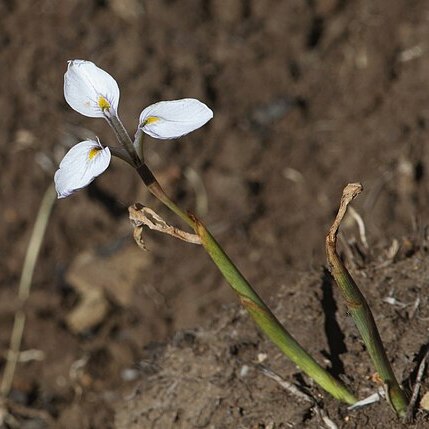Perennial herb, geophyte, 0.16-0.45 m high; corm tunics of fine, brownish, reticulate fibres; stem slender, erect, usually simple. Leaf 1, dry or lacking at flowering time, terete. Spathes green, apex brown, attenuate. Inflorescence with white to pale blue-mauve flowers; outer tepals flushed purple on reverse; inner tepals and crests usually dark purple; nectar guides yellow, edged with bluish spots; tepals unequal, outer 20-27 mm long, claw erect, inner 2-6 mm long, linear or trifid with central cusp larger. Stamens: filaments 4-6 mm long, united to half length; anthers 4.0-5.5 mm long; pollen pale yellow. Ovary 7-10 mm long, cylindric; style branches 7-10 mm long; crests 4-6 mm long, linear. Flowering time Sept.-Nov. Capsule obovoid.
Cormous geophyte, up to 200 mm high. Leaf solitary, absent at flowering. Flowers: perianth with inner segments reduced to linear or ciliate cusps, 3-6 mm long, outer segments 20-27 mm long, claw nearly erect, segments white to pale blue mauve, inner segments and style crests usually dark purple, nectar guides yellow; Sep.-Nov.
Cormous herb, up to 200 mm tall. Inner tepals reduced to tiny trifid or linear cusps, 3-6 mm long. Outer tepals 20-27 mm long, claw nearly erect. Flowers white to pale blue-mauve, inner tepals and style crests usually dark purple, nectar guides yellow.

